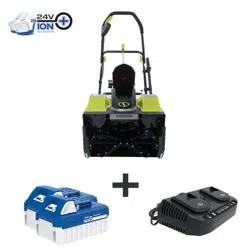Loading ...
Loading ...
Loading ...

4
9. Charging batteries at a temperature below 41°F (5°C) will
cause chemical damage to the cells and may cause a re.
10. Do not use batteries that have been exposed to heat
during the charging process, as the battery cells may have
suered dangerous damage.
11. Do not use batteries that have suered curvature or
deformation during the charging process or those that
exhibit other atypical symptoms (gassing, hissing,
cracking, etc.)
12. Never fully discharge the battery pack (maximum
recommended depth of discharge is 80%). A complete
discharge of the battery pack will lead to premature aging
of the battery cells.
Protectionfromenvironmentalinuences
1. Wear suitable work clothes. Wear safety goggles.
2. Protect your cordless tool and the battery charger from
moisture and rain. Moisture and rain can cause dangerous
cell damage.
3. Do not use the cordless tool or the battery charger near
vapors and ammable liquids.
4. Use the battery charger and cordless tools only in dry
conditions and at an ambient temperature of 50ºF – 104°F
(10°C – 40°C).
5. Do not keep the battery charger in places where the
temperature is liable to reach over 105°F (40.5°C).
In particular, do not leave the battery charger in a car that
is parked in the sunshine.
6. Protect batteries from overheating. Overloads,
overcharging and exposure to direct sunlight will result
in overheating and cell damage. Never charge or work
with batteries that have been overheated – replace them
immediately, if possible.
7. Store the charger and your cordless tool only in dry
locations with an ambient temperature of 50ºF – 104°F
(10°C – 40°C). Store your lithium-ion battery pack in a
cool, dry place at a temperature of 50 – 68°F (10 – 20°C).
Protect the battery pack, charger and cordless tool from
humidity and direct sunlight. Only place fully charged
batteries in storage.
8. Prevent the lithium-ion battery pack from freezing.
Battery packs that were stored below 32°F (0°C) for more
than 60 minutes must be discarded.
9. When handling batteries, be wary of electrostatic charge.
Electrostatic discharges can damage the electronic
protection system and the battery cells. Avoid electrostatic
charging and never touch the battery poles.
Additional Safety Instructions
Safety Instructions for Walk-Behind
Snow Blowers
• Read the operator’s manual carefully – Learn your snow
blower’s applications and limitations as well as the specic
potential hazards related to this machine. Do not use this
machine for any purpose other than the one for which it
was designed. Failure to adhere to these precautions may
cause mechanical defaults, serious damage, or personal
injury.
• Preliminary unit inspection – Thoroughly inspect the unit
before use. Make sure all the parts are secure and installed
correctly. If you notice any abnormalities, do not use the
machine until it has been properly repaired.
Always perform a test run the rst time you use the snow
blower or after replacing parts to ensure that the unit is
functioning properly.
• Preliminary area inspection – Clear the area to be plowed
before each use. Remove all objects such as rocks,
broken glass, nails, wire, or string, which can be thrown by
or become entangled in the snow blower. Keep the area of
operation clear of all people, children, and pets.
• Excessive force – The snow blower was designed to
respond at a certain rate for various snow conditions for
optimal safety and performance. Do not force it; keep the
applied pressure constant throughout its operation.
• Malfunctioning switch – Do not use the snow blower if
the switch does not turn it on and o. Any appliance that
cannot be controlled by the switch is not safe to use and
must be repaired.
• Hitting an object – If the snow blower accidentally strikes
an object, rst stop the snow blower and remove the
battery; next, inspect for damage; nally, repair or replace
any damaged part before restarting and operating the
snow blower.
• Discharge chute safety – Never direct the snow discharge
chute at the operator, at bystanders, at vehicles, or at
windows. The discharged snow, which may contain foreign
objects accidentally picked up by the snow blower,
can cause serious damage and personal injury. Do not use
your hands to unclog the discharge chute. Stop the motor
before removing debris.
• Hand-held operating position – Operation of the snow
blower in the hand-held position is unsafe.
• Abnormal operation – If you nd that the snow blower
is not running properly or hear abnormal sounds or feel
abnormal vibrations from the motor, immediately stop the
machine, remove the battery, and contact an authorized
Snow Joe
®
+ Sun Joe
®
dealer or call the Snow Joe
®
+
Sun Joe
®
customer service center at 1-866-SNOWJOE
(1-866-766-9563) for assistance.
• Noise control – When using the snow blower, respect
the local laws and regulations regarding noise control and
environmental protection. To avoid noise disturbance,
you should carefully decide upon an appropriate operation
time and consider the surrounding conditions.
Loading ...
Loading ...
Loading ...
